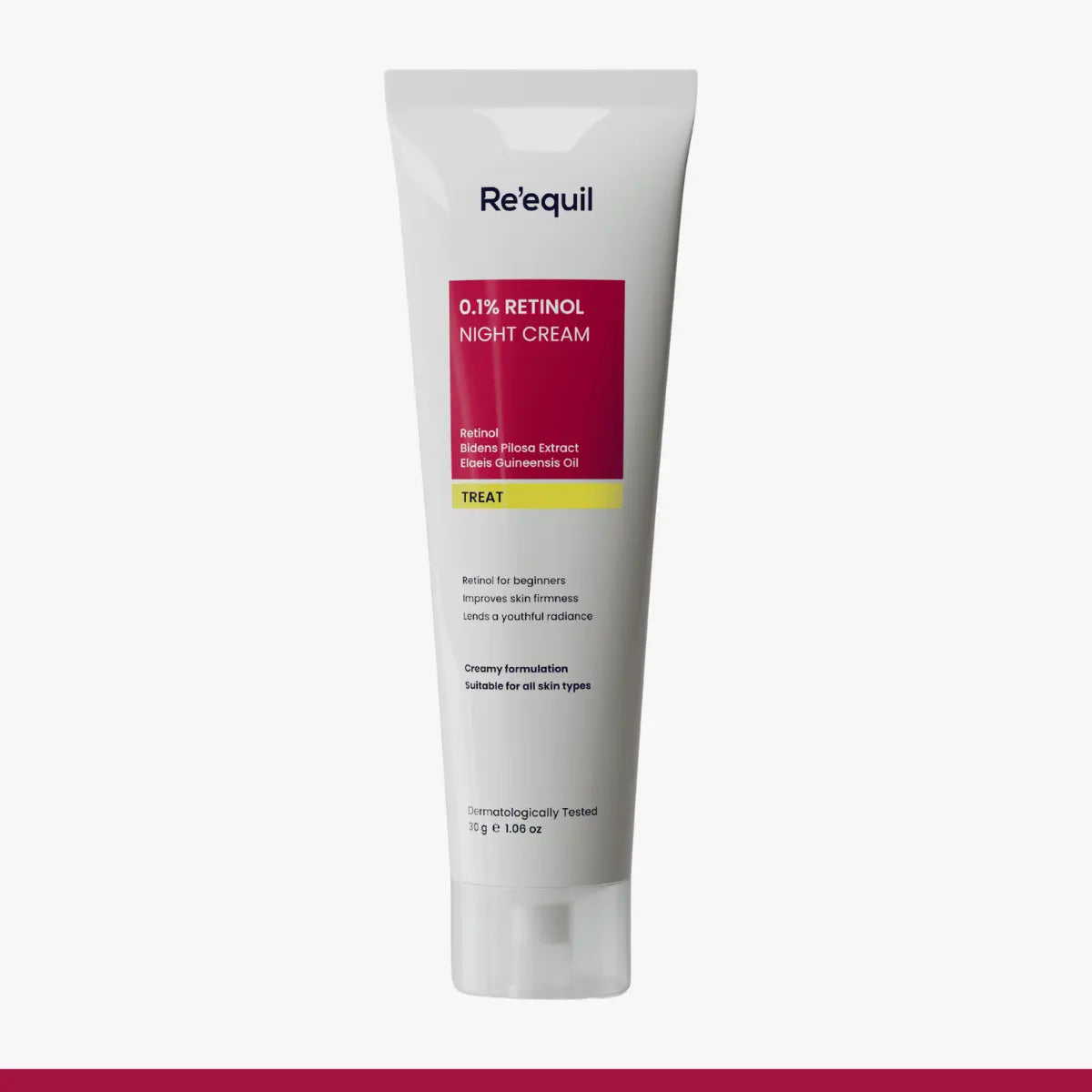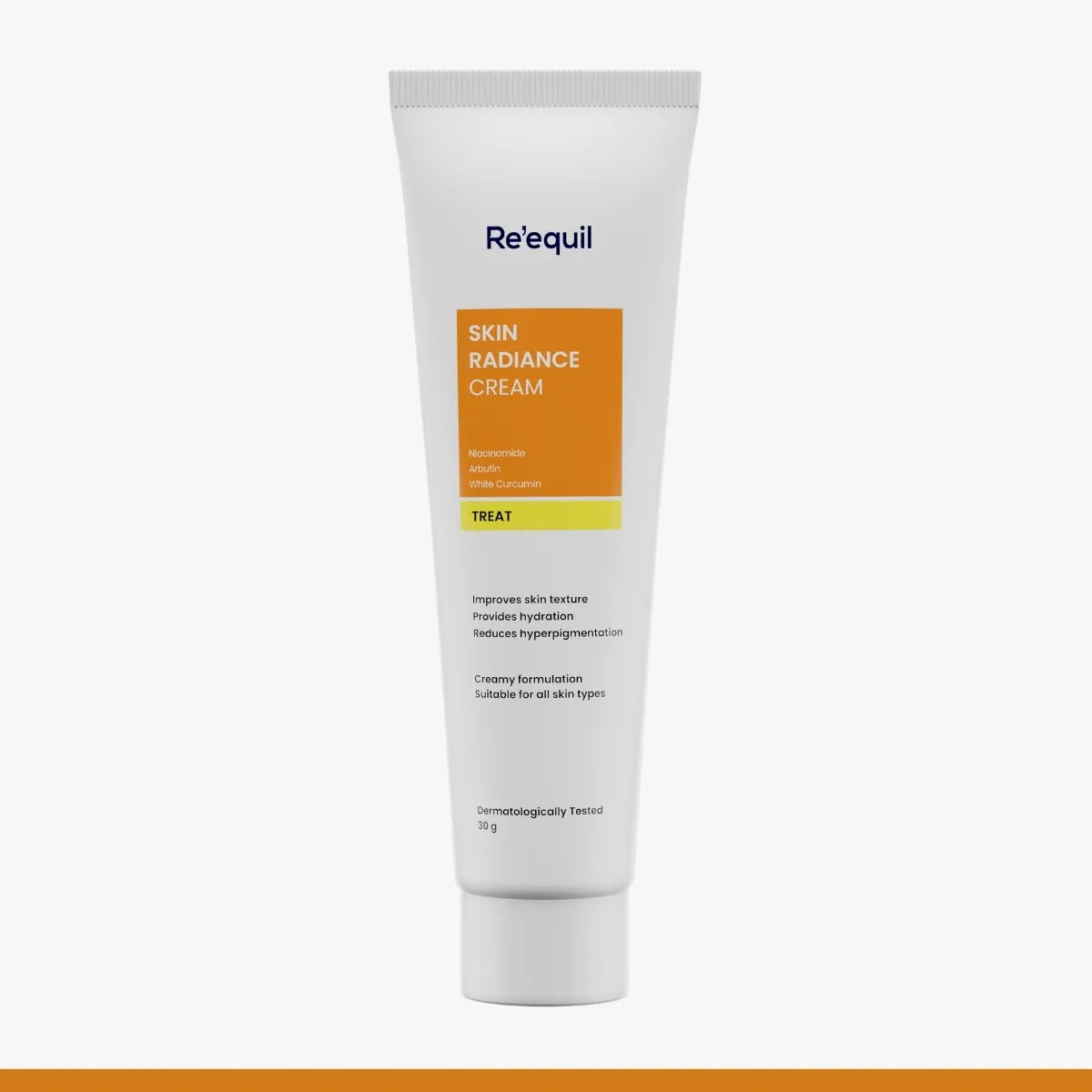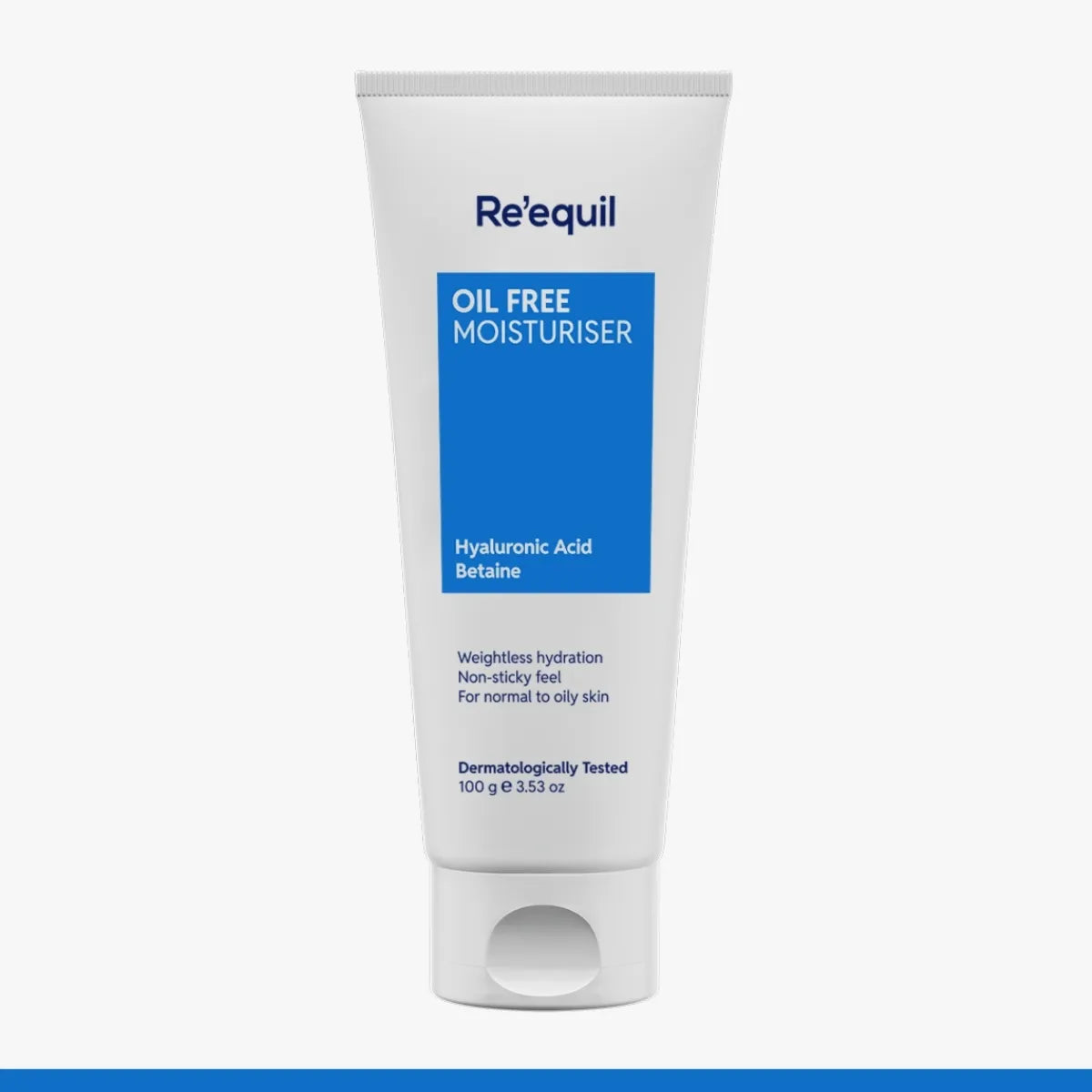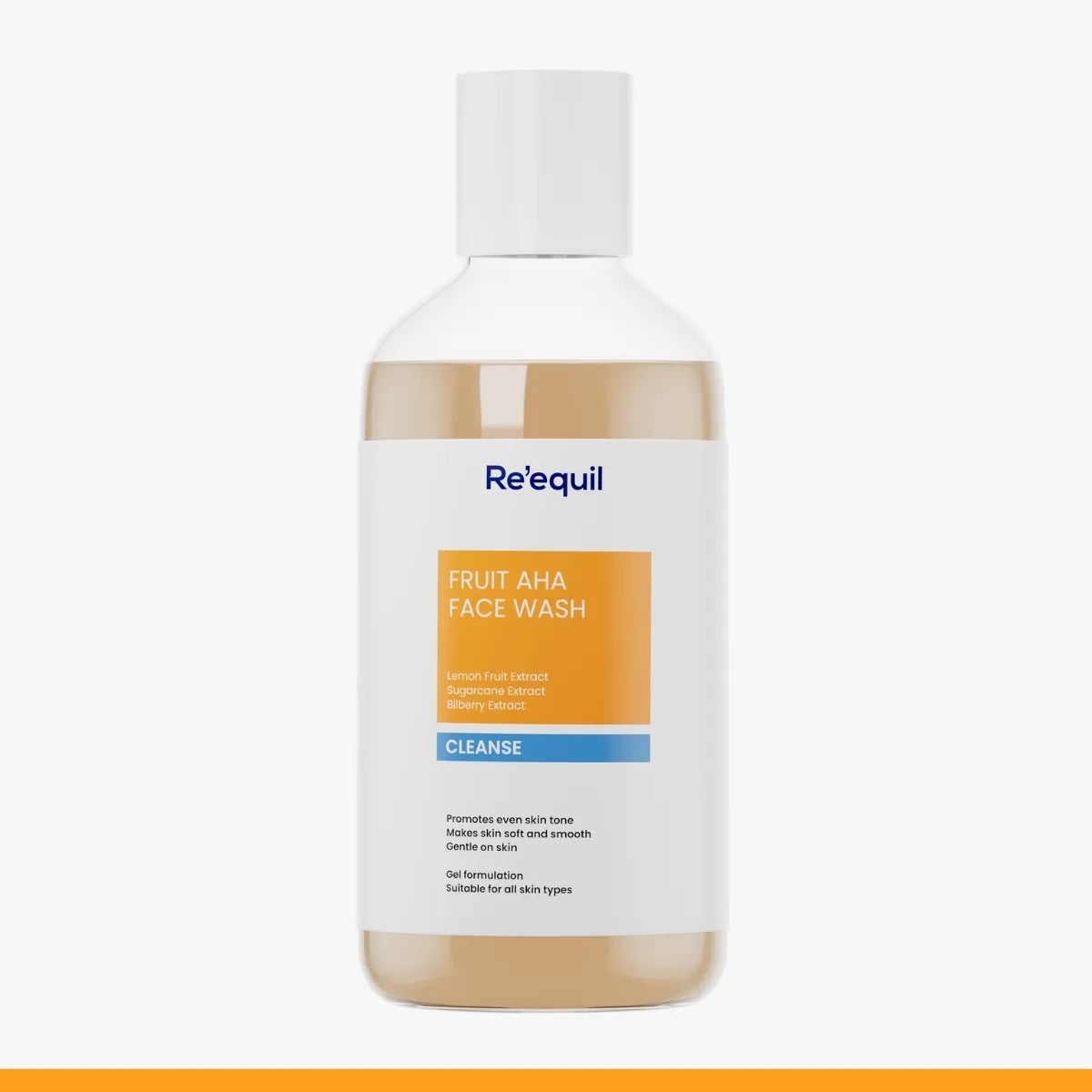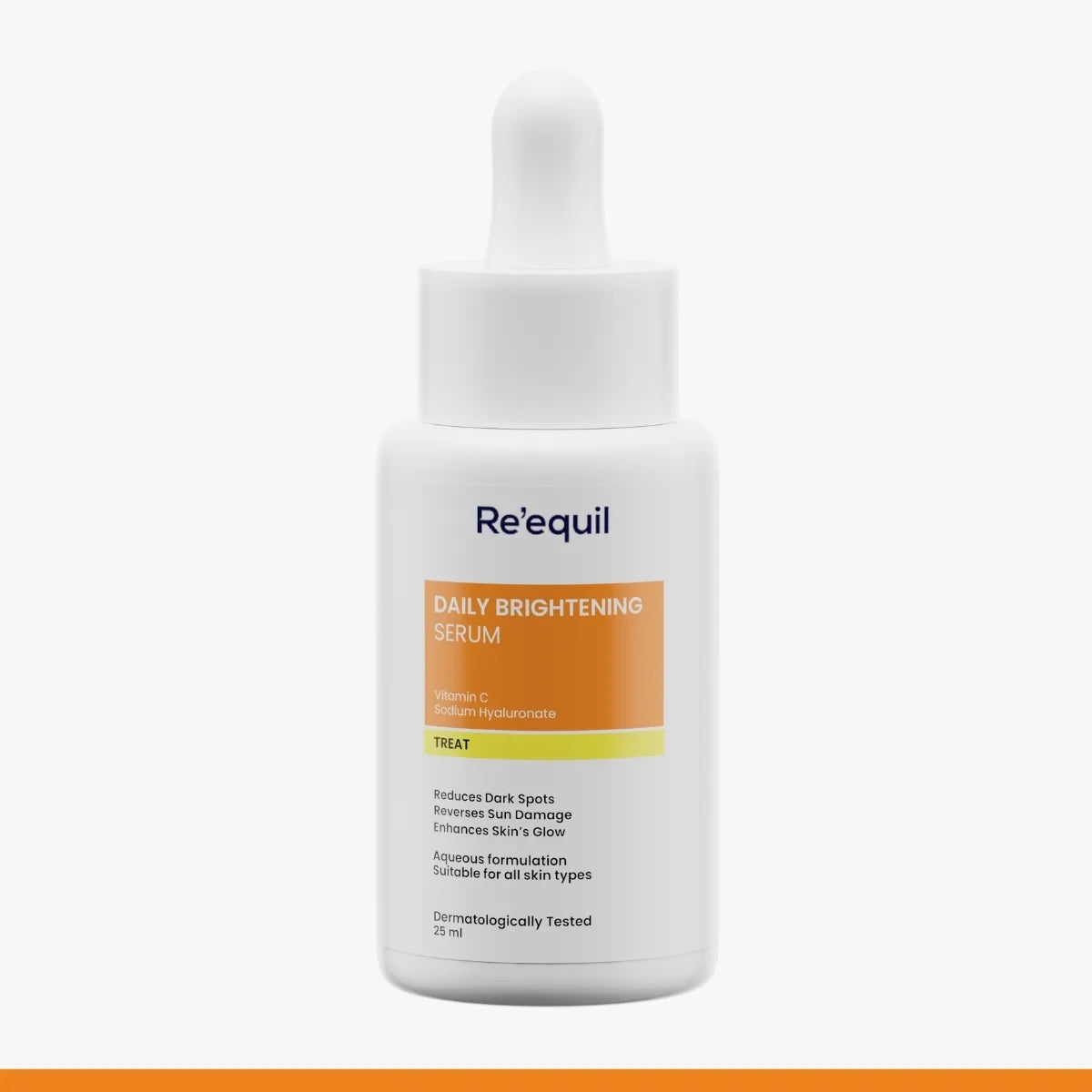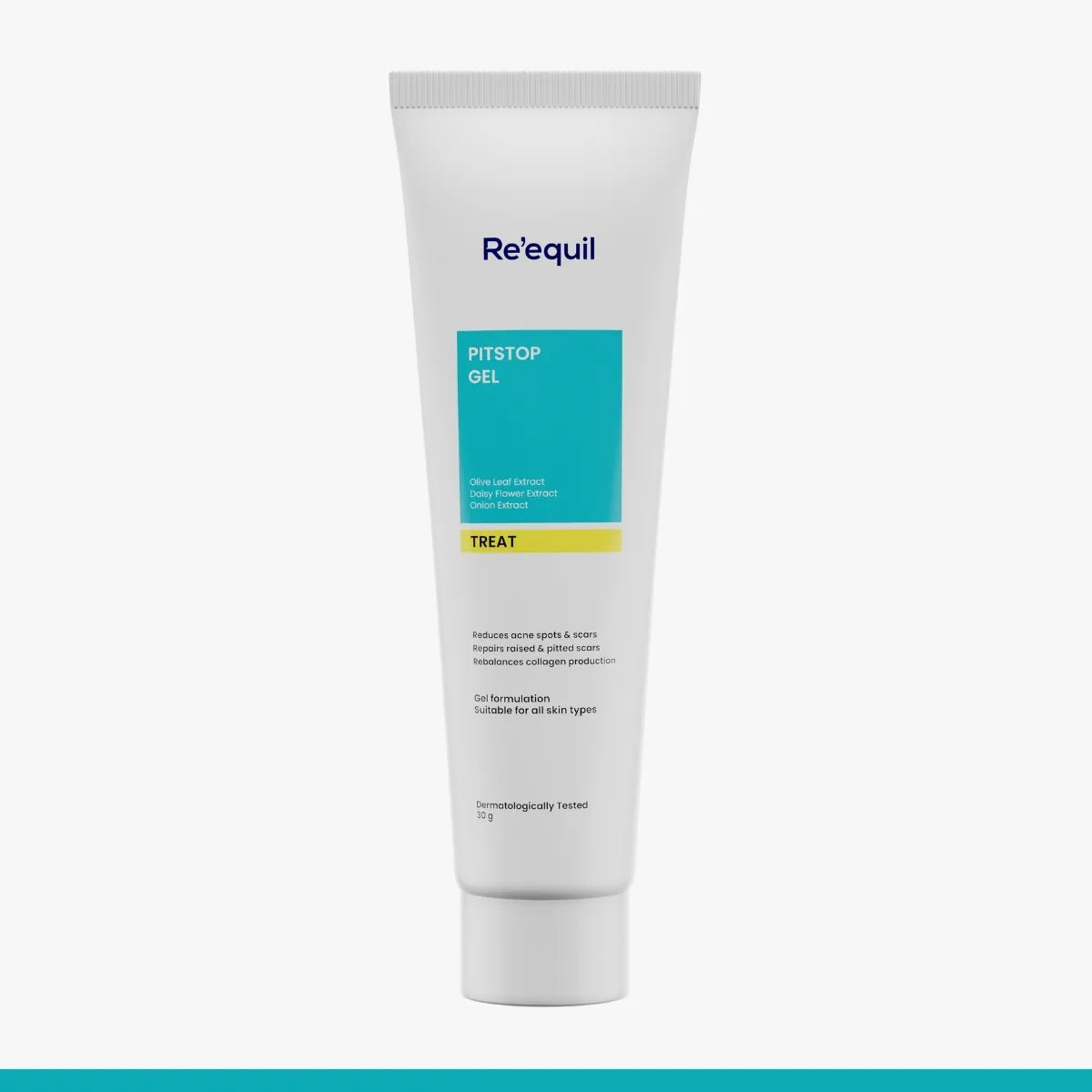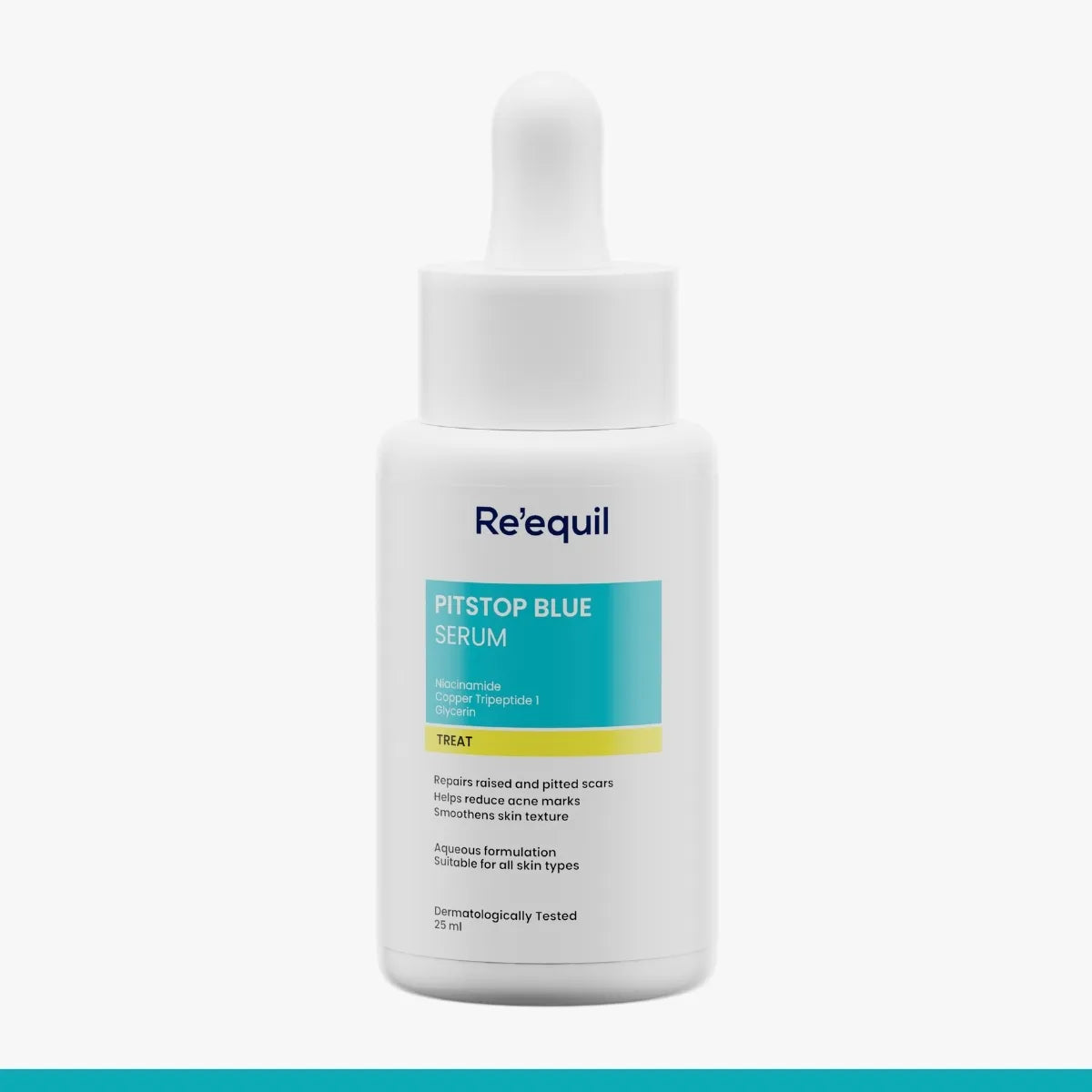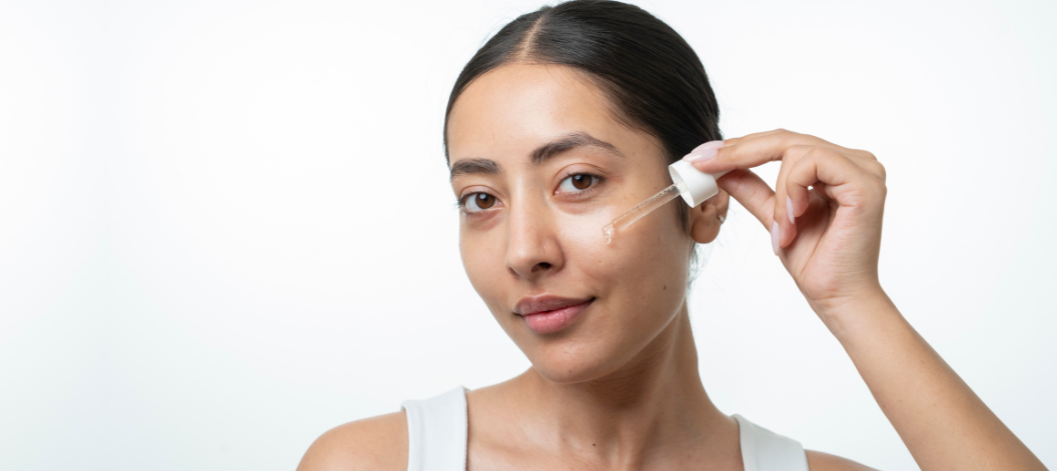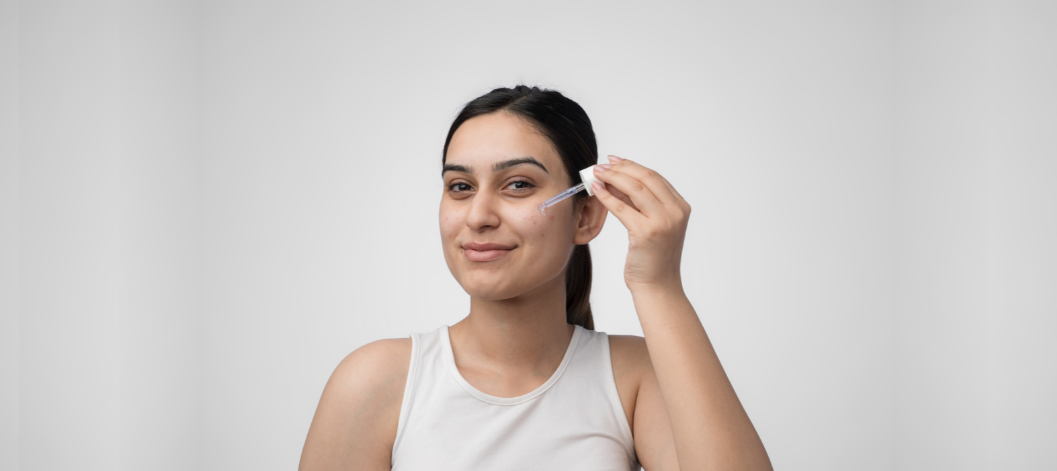
7 Skincare Ingredients That Actually Work for Hormonal Acne
Still breaking out despite “treating your acne”?
You’re not alone—and no, it doesn’t always mean you’re doing something wrong.
The more likely explanation: your products don’t contain what your skin actually needs.
Products with labels like “for acne-prone skin” doesn’t mean it's the product for your acne.
What really matters is what’s inside it—the active ingredients, their concentrations, and how they interact with each other on your skin.
The wrong combo can stall your progress. The right one can shift everything.
Below is a list of 8 science-backed ingredients that actually pull their weight when it comes to acne.
1. Glycolic Acid
Glycolic Acid is the smallest molecule in the alpha-hydroxy acid (AHA) family—which is exactly why it sinks into your skin faster than the rest.
And when it does, it doesn’t just exfoliate on the surface—it works within the deeper layers, making it one of the most effective chemical exfoliants we have access to.
What makes it even more interesting is how it handles dead skin cells.
Dead skin cells in the outermost layer are bonded to one another tightly. Glycolic Acid loosens the bonds holding them in place, so the skin can shed them more easily.
This speeds up cell turnover, making room for newer, healthier skin cells—making Glycolic Acid an effective skincare for acne-prone skin.
But GA doesn’t stop at exfoliation.
A 2020 study confirmed that Glycolic Acid also boosts collagen production—even at lower concentrations.
That means it's not just about smoothing texture and preventing acne—it’s actively reversing signs of photoaging, restoring skin resilience at the cellular level.
Niacinamide
Niacinamide reduces the severity of acne—it actively rewires how your skin responds to inflammation.
A 4% concentration has been shown to reduce mild to moderate acne, including pustules, without the harsh side effects you’d expect from traditional treatments.
In one study of participants aged 18 to 25, most saw visible improvements. Only a few reported mild itching or burning—nothing significant.
Topical Niacinamide can boost AMPs in humans, providing the skin with long-lasting protection against bacteria.
It boosts antimicrobial peptides (AMPs)—your skin’s built-in defense molecules. These aren’t just passive protectors; they actively kill off bacteria that fuel breakouts by triggering inflammation or infection.
Moreover, A study in the Journal of Cosmetic and Laser Therapy found that using 2% topical Niacinamide consistently for four weeks led to a noticeable drop in sebum production.
Regulated sebum means fewer clogged pores—which means fewer comedones (blackheads, whiteheads, the usual suspects).
Retinol
Yes—retinol is clinically approved for acne.A2021 review says that Retinol is highly effective in treating acne and also improves hyperpigmentation.
Another large-scale analysis of thousands of patients confirms that retinol works on both inflammatory acne (like pustules) and non-inflammatory lesions (like blackheads and whiteheads).
What makes retinol so effective is its ability to keep your pores unclogged.
That’s the bottleneck for most acne: a pore gets blocked with oil, dead cells, or both, and it creates the perfect storm for inflammation and breakouts.
Retinol speeds up cell turnover, clears out buildup, and prevents pores from getting clogged in the first place.
Salicylic Acid
Salicylic Acid is a beta-hydroxy acid (BHA) that targets the skin’s outermost layer—the stratum corneum—breaking down dead cells and clearing them out.
It’s oil-soluble, which means it doesn’t just sit on the surface; it goes deeper, into the pore lining, where most breakouts begin.
It’s also one of the few chemical exfoliants classified as a safe, controlled peeling agent.
A 2015 study confirms its use in treating a wide range of skin concerns—acne, pigmentation, photodamage, even inflammatory flare-ups.
Unlike aggressive peels, salicylic acid works with the skin’s own healing response by inducing a controlled exfoliation, just enough to push the skin into renewal mode without causing adverse effects.
Moreover, A 2012 clinical study tested Salicylic Acid in a daily-use cleanser on individuals aged 12 to 30 with mild to moderate acne.
After 8 weeks, every participant showed a clear reduction in acne lesions—without needing prescription-strength formulas.
Zinc PCA
Zinc PCA actively interferes with the root causes of acne.
Backed by research, it combines five crucial properties in one molecule: it regulates oil, calms inflammation, fights bacteria, accelerates wound healing, and offers antioxidant defense.
That makes it one of the most multi-functional acne ingredients we have access to.
This helps prevent pores from getting clogged with excess oil, reducing the formation of blackheads and whiteheads (comedones).
But acne isn’t just an sebum problem—it’s an inflammatory condition.
Zinc PCA helps on that front too. It reduces redness and swelling, making your skin feel less irritated and more stable.
Peptides
Peptides break through bacterial membranes—that’s how they fight acne-causing bacteria fast, with both antimicrobial and anti-inflammatory effects working in tandem.
But clearing acne is only half the story.
What follows—post-inflammatory hyperpigmentation (PIH) and pitted scarring—is where most people get blindsided.
These marks don’t appear randomly. They’re the result of disrupted collagen during the healing phase—too little, and you get atrophic (sunken) scars; too much, and you get raised ones.
Copper tripeptides boost collagen in a regulated way, reduce inflammation, and support the skin’s repair systems—all without overwhelming it.
That makes them especially helpful for smoothing out uneven texture and calming down inflamed skin post-breakout.
Research also shows that combining copper peptides with niacinamide and hyaluronic acid (sodium hyaluronate) significantly improves post-acne marks, particularly pigmentation.
Hyaluronic Acid
Hyaluronic Acid has built its reputation on hydration—but that’s not the whole story.
It's not just for dry or ageing skin. Oily, acne-prone skin needs it just as much—maybe more.
Here’s why: oily skin is often dehydrated skin.
When your skin lacks water, it compensates by overproducing oil. That excess sebum is what clogs pores, causes inflammation, and gives you that constant greasy shine.
A 2017 study on individuals with oily skin found that Hyaluronic Acid helps regulate sebum production.
It hydrates the skin deeply without triggering oiliness, making it an effective way to bring the skin back into balance.
And it’s not going to clog your pores either—Hyaluronic Acid has a comedogenicity rating of 0.
So, if your skin is oily, stripped, and reactive, hydration might be the missing piece. And Hyaluronic Acid? It’s one of the few ingredients that can deliver hydration, not oil, exactly where it’s needed—without getting in your skin’s way.
More articles to feed your curiosity...
Is it okay to use Niacinamide if you have acne?
Acne, a common skin condition affecting millions worldwide, can be challenging to manage due to its multifactorial nature. From hormonal imbalances to excess oil production, various factors contribute to acne's development. Among the myriad of treatments available, Niacinamide has emerged as a promising ingredient in acne care. This article explores how Niacinamide can help with acne and improve overall skin health. How does acne develop? To understand how Niacinamide helps with acne, it is essential to know the primary factors contributing to this condition: 1. Excess Sebum Production: Overactive sebaceous glands produce more oil than needed, leading to clogged pores. 2. Clogged Pores: Dead skin cells, debris and oil accumulate in pores, creating a breeding ground for acne-causing bacteria. 3. Inflammation: Acne lesions are often accompanied by redness and swelling due to inflammatory responses. 4. Bacterial Growth: Propionibacterium acnes (P. acnes), a bacteria thriving in clogged pores, exacerbates acne by producing inflammatory mediators. Niacinamide addresses these factors through multiple mechanisms, making it a comprehensive solution for acne management. What is Niacinamide? Niacinamide, also known as nicotinamide, is a water-soluble form of vitamin B3. It is a versatile ingredient in skincare, celebrated for its anti-inflammatory, antioxidant and skin barrier-repairing properties. Unlike other active ingredients, Niacinamide is gentle on the skin, making it suitable for various skin types, including sensitive and acne-prone skin. Benefits of Niacinamide for acne-prone skin Niacinamide has become a standout ingredient for acne-prone skin due to its multi-faceted benefits. It not only targets the root causes of acne but also supports the skin in its healing process. From calming inflammation to enhancing the skin’s natural defences, Niacinamide offers a gentle yet effective solution for managing acne and improving overall skin health. Lets dive into the key benefits that make it such a popular choice for those struggling with acne: 1. Reduces Inflammation Acne is fundamentally an inflammatory condition. Research has shown that Niacinamide possesses potent anti-inflammatory properties, reducing redness, swelling and irritation associated with acne lesions. By modulating inflammatory cytokines, Niacinamide calms active breakouts and prevents the worsening of existing acne. 2. Regulates Sebum Production Excessive oil production is one of the primary triggers of acne. A study published in the Journal of Cosmetic and Laser Therapy demonstrated that a 2% topical Niacinamide formulation significantly reduced sebum production rates over four weeks. By regulating sebum, Niacinamide minimizes pore blockages and prevents the formation of comedones (whiteheads and blackheads). 3. Improves Skin Barrier Function A compromised skin barrier can worsen acne by allowing external irritants and bacteria to penetrate the skin. Niacinamide enhances the production of ceramides—lipids essential for maintaining a healthy skin barrier. By strengthening the barrier, Niacinamide reduces sensitivity and irritation, common issues for acne-prone individuals. 4. Prevents Clogged Pores Niacinamide regulates keratinocyte activity, meaning, it prevents the buildup of dead skin cells that contribute to clogged pores. This action reduces the likelihood of acne formation, particularly non-inflammatory types such as blackheads. 5. Antibacterial Effects Although not a direct antibiotic, Niacinamide’s anti-inflammatory properties indirectly curb the proliferation of acne-causing bacteria like P. acnes. Combined with its ability to regulate sebum, this creates an unfavorable environment for bacterial growth. 6. Minimizes Acne Scarring and Hyperpigmentation Post-inflammatory hyperpigmentation (PIH) and acne scars are common aftermaths of acne. Niacinamide inhibits melanin transfer to skin cells, reducing the appearance of dark spots. Moreover, its role in stimulating collagen production aids in improving skin texture and minimizing scars over time. Niacinamide for acne-prone skin—what do clinical studies say Several scientific studies have examined the benefits of Niacinamide in acne treatment, revealing promising results. These clinical trials provide valuable insights into how Niacinamide can help manage acne while improving overall skin health. A randomized clinical trial published in the International Journal of Dermatology compared 4% Niacinamide gel to 1% clindamycin gel in treating acne. The results revealed comparable efficacy, with the added benefit of Niacinamide’s anti-inflammatory and barrier-strengthening properties. Research published in the Journal of Cosmetic Dermatology highlighted Niacinamide’s effectiveness in decreasing sebum production and pore visibility, both critical factors in acne management. A study published in the Dermatology and Therapy journal found that a 2% Niacinamide solution effectively reduced acne lesions and inflammation in participants over a 12-week period, further supporting its role as a beneficial treatment for acne-prone skin. How to add Niacinamide into your skincare routine? Incorporating Niacinamide into your skincare routine can be a game-changer for managing acne and improving overall skin health. Its versatility makes it easy to combine with other ingredients, providing a balanced approach to skincare. Here is a step-by-step guide to seamlessly add Niacinamide into your daily regimen for optimal results - 1. Cleansing Start with a gentle, pH-balanced cleanser to remove impurities and prepare your skin for better absorption of active ingredients. 2. Niacinamide Application Apply a Niacinamide serum after cleansing. Most formulations range from 2% to 12% concentration. For beginners, starting with a lower concentration is recommended to avoid potential irritation. 3. Moisturizing Follow up with a lightweight, non-comedogenic moisturiser to lock in hydration and reinforce the skin barrier. Products containing Ceramides or Hyaluronic Acid pair well with Niacinamide. 4. Sun Protection Niacinamide does not make the skin photosensitive, but sunscreen remains essential to protect against UV damage and prevent hyperpigmentation. Go for a non-greasy, broad-spectrum SPF 50, preferably oxybenzone free. 5. Pairing with Other Actives When incorporating Niacinamide into your skincare routine, it is important to know which ingredients work well together to maximize its benefits. Niacinamide is compatible with a variety of other actives, allowing you to tailor as per your skin’s regimen, while targeting acne and promoting overall skin health. Here are some key ingredients that complement Niacinamide for a more effective skincare routine - Salicylic Acid: Salicylic acid penetrates deep into pores, exfoliates dead skin cells, and helps prevent acne by unclogging pores and reducing inflammation. Retinol: Retinol boosts cell turnover to prevent clogged pores and acne, while also promoting collagen production to reduce acne scars and fine lines. Hyaluronic Acid: Hyaluronic acid hydrates and plumps the skin, ensuring moisture retention without clogging pores, making it an essential ingredient when using acne treatments. Additional benefits of Niacinamide for skin Beyond acne, Niacinamide offers a range of benefits for overall skin health: Enhances skin elasticity: Regular use of Niacinamide boosts collagen and elastin production, improving skin firmness and reducing fine lines. Protects against environmental aggressors: Niacinamide’s antioxidant properties shield the skin from oxidative stress caused by pollution, UV rays, and other environmental factors. Reduces redness and blotchiness: Niacinamide has anti-inflammatory properties that help calm redness and irritation, making it beneficial for sensitive or rosacea-prone skin. Potential Side Effects of Niacinamide Niacinamide is generally well-tolerated by most skin types, making it a popular choice in skincare. However, in rare cases, some individuals may experience mild side effects, especially when using highly concentrated formulas or combining it with other active ingredients. Here's what to watch for: Redness: Some users may notice temporary redness, especially if their skin is sensitive or not used to active ingredients. Itching: Mild itching can occur as the skin adjusts to Niacinamide, particularly when introduced too quickly or in higher doses. Dryness: Although Niacinamide is known for its hydrating benefits, certain formulations might cause dryness if they include alcohol or other drying agents. Conclusion Niacinamide is an effective ingredient for acne care. It helps reduce inflammation, controls excess oil and prevents clogged pores. It also strengthens the skin barrier and fades pigmentation. Backed by strong scientific research, it is a safe and reliable option for managing mild to moderate acne. Regular use of Niacinamide can lead to clearer, healthier, and more radiant skin over time. For individuals struggling with persistent or severe acne, combining Niacinamide with a dermatologist-recommended treatment plan can maximize its benefits and address specific skin concerns effectively. Frequently Asked Questions 1. Can Niacinamide treat cystic acne? Niacinamide can help reduce inflammation and regulate sebum production, but it may need to be paired with stronger treatments like retinoids or antibiotics for cystic acne. 2. Is Niacinamide better than salicylic acid for acne? Niacinamide and salicylic acid serve different purposes. While Niacinamide soothes and strengthens the skin, salicylic acid exfoliates and unclogs pores. Their combined effect often yields the best results 3. Can I use Niacinamide every day if I have acne? Yes, Niacinamide is gentle enough for daily use. Most formulations can be applied twice daily for optimal benefits.
Is Vitamin C effective for oily, acne-prone skin?
Oily skin often comes with its own set of challenges, including acne, clogged pores and excessive sebum production. Many people with oily skin are cautious when choosing skincare ingredients, fearing they might worsen their concerns. Vitamin C, an effective antioxidant, has gained immense popularity in skincare routines, but is it suitable for oily skin? Let’s explore the benefits of Vitamin C, its compatibility with oily and acne-prone skin and the best practices for incorporating it into your routine. Is Vitamin C Good for oily, acne-prone skin? The answer is a resounding YES. Vitamin C is not only suitable for oily skin but also offers multiple benefits tailored to its unique needs. Vitamin C can regulate oil production in skin and prevent clogged pores. This makes it a safe and effective ingredient for managing acne-prone skin without causing further breakouts. Key benefits of Vitamin C for oily and acne-prone skin Oily and acne-prone skin requires a delicate balance between controlling excess oil, preventing breakouts and promoting healing. Vitamin C stands out as an ideal ingredient for oily skin type due to its ability to address multiple concerns simultaneously. Here are the key benefits - 1. Reduces inflammation Acne often causes redness and irritation, which can worsen the appearance of breakouts. Vitamin C has anti-inflammatory properties that help calm the skin and reduce redness. It helps soothe inflamed areas without causing further irritation. 2. Boosts collagen production Vitamin C stimulates collagen synthesis, which helps to repair the skin, reduce acne scarring and maintain skin elasticity. Vitamin C acts as a cofactor for prolyl and lysyl hydroxylase, enzymes crucial for collagen synthesis. This boost in collagen production strengthens the extracellular matrix, enhancing the skin's barrier function and reducing pore size. 3. Fades dark spots Vitamin C inhibits tyrosinase, an enzyme critical in melanin synthesis. It reduces post-inflammatory hyperpigmentation (PIH). This is especially important for those with acne-prone skin, as scarring can be a persistent issue after breakouts. 4. Protects skin against environmental damage Vitamin C is a potent antioxidant that shields the skin from harmful free radicals caused by environmental factors like pollution and UV exposure. This protection is vital for acne-prone skin, as environmental damage can worsen inflammation and trigger more breakouts. 5. Regulates oil production While Vitamin C does not directly control sebum production, it immensely helps maintain skin balance and overproduction of oil. It also helps support the skin’s natural processes, leading to fewer clogged pores. 6. Brightens and even skin tone Vitamin C helps fade dark spots, hyperpigmentation, and acne scars, promoting a more even skin tone. How to use Vitamin C serum for oily skin? Adding Vitamin C serum to your skincare routine can transform your skin – but applying it the right way is key to getting the best results and avoiding irritation. Here’s a simple step-by-step guide: Choose the right formulation Look for serums containing L-ascorbic acid, a highly effective form of Vitamin C. Opt for lightweight, non-comedogenic formulations that will not clog pores. Products designed specifically for oily skin types work best. Cleanse first Always start with a gentle cleanser to remove dirt and excess oil before applying Vitamin C serum. A clean base allows for better absorption, enhancing the serum's effectiveness. Apply in the morning Vitamin C works best when applied in the morning as it protects the skin from environmental damage. Pairing it with sunscreen amplifies this protection. Follow up with Sunscreen Since Vitamin C enhances the skin’s sensitivity to sunlight, always follow up with a broad-spectrum sunscreen. This combination acts as a powerful shield against harmful UV rays. Start slowly If you are new to Vitamin C, begin with a lower concentration (5%) and gradually move to higher concentrations (10-15%) as your skin builds tolerance. This prevents irritation and allows your skin to adjust comfortably. Layer with compatible products Pair Vitamin C with Hyaluronic Acid to keep your skin hydrated and balanced. Avoid using it alongside potent actives like Retinol or Benzoyl Peroxide to reduce the risk of sensitivity. Does Vitamin C clog pores? One of the biggest concerns for people with oily skin is whether a product will clog their pores and lead to breakouts. Fortunately, Vitamin C is non-comedogenic, meaning it does not clog pores. In fact, it can help: Prevent clogging of pores: By reducing excess sebum production and promoting skin cell turnover, Vitamin C helps keep pores clear. Combats blackheads and whiteheads: Its exfoliating properties can remove dead skin cells that contribute to blackheads and whiteheads. Pro tips for using Vitamin C with oily skin Maximise the benefits of Vitamin C for oily skin by using it correctly to avoid irritation or clogged pores. Here are pro tips to maintain balance and clarity in your routine - Layer wisely: Avoid layering Vitamin C with exfoliating acids like AHA/BHA to prevent irritation. Stick to a simple routine. Store properly: Vitamin C is sensitive to light and air, which can reduce its effectiveness. Store your serum in a cool, dark place and ensure the packaging is airtight. Monitor your skin’s reaction: Watch for signs of sensitivity, such as redness or stinging. If these occur, reduce usage frequency or switch to a lower concentration. Sunscreen is a must: Always pair Vitamin C with a broad-spectrum sunscreen to protect your skin from UV damage and enhance its brightening effects. Potential side effects and considerations for oily skin While Vitamin C is highly beneficial, it is essential to use it correctly to avoid potential side effects, especially for oily skin. Here are some considerations: Initial breakouts: Some individuals may experience purging as Vitamin C accelerates skin cell turnover, temporarily bringing impurities to the surface. Irritation or redness: High concentrations of Vitamin C, particularly in sensitive or acne-prone skin, can cause redness, itching, or a stinging sensation. Start with lower concentrations and gradually increase it. Oxidation concerns: Vitamin C is unstable and can oxidise when exposed to air or light, potentially irritating the skin or losing effectiveness. Choose products in airtight, opaque packaging and store them in a cool, dark place. Conclusion Vitamin C is a skincare superstar that is perfectly suited for oily skin. Its ability to regulate oil production, fight acne, brighten post-acne marks and improve overall skin health makes it a valuable addition to your routine. By choosing the right formulation and following proper application techniques, you can unlock radiant, healthy skin without compromising your skin’s natural balance. Whether you are battling acne, struggling with oily shine or looking to brighten your complexion, Vitamin C can help you achieve your skincare goals. Just remember to pair it with a consistent sunscreen application and enjoy the transformative benefits of this powerful ingredient.
Should You Use Hyaluronic Acid If You Have Oily or Acne-Prone Skin?
Hyaluronic Acid: What is it and how it helps the skin When it comes to hydrating the skin—there really isn’t any skincare ingredient that can do a better job than Hyaluronic Acid. It is one of the most well-known skincare ingredients in the market today—and for all the good reasons. It is typically found in skincare formulations targeting skin concerns like dryness and facial ageing. There are 4 forms of Hyaluronic Acid available in cosmetic formulations Raw form. Has a higher molecular weight, and mostly stays on the top layer of the skin. Hydrolyzed form. Split into smaller fragments, has a lower molecular weight. Alkaline form, also called Sodium Hyaluronate. This one is the most effective form of Hyaluronic Acid. It has a lower molecular weight and penetrates deeper layers of the skin. Plus, it promotes the production of naturally occurring HA. Cross-linked form. Low molecular weight hyaluronic acid (HA) molecules are cross-linked to create a larger, more stable molecule. READ - A complete guide on Hyaluronic Acid Why you might need Hyaluronic Acid Hyaluronic Acid, also known as Hyaluronan, is already present in our body—it is mainly found in our connective, epithelial and neural tissues. According to a study, an individual weighing 70 kg has approximately 15g of Hyaluronan in the body. Its prime job is to lubricate the joint and retain the essential moisture in our stratum corneum—the outermost layer of the skin. With that comes a question—if we already have HA in our body—then what are these topical products for. Here’s a catch! As we age, Hyaluronic Acid in our body declines. Thus, skincare products containing HA can be a great addition to your skincare routine. Hyaluronic Acid decreases skin irritation HA contains healing properties, which can help minimise skin irritation. According to a study, Hyaluronic Acid controls skin inflammation, speeding up the healing process. Moreover, it increases blood flow to the areas where the skin barrier is compromised. Reduces the appearance of fine lines and wrinkles According to a 2012 study, hyaluronic acid moisturises the skin and improves skin elasticity, thus visibly decreasing the depth of wrinkles. Moreover, a serum containing HA can improve smoothness, hydration, and the appearance of fine lines, according to a 2021 study. The study was conducted on 40 females—which went on for 6 weeks—none reported skin irritation or any side effect from Hyaluronic Acid. HA improves the penetration of other active ingredients If you happen to use any active ingredient, Hyaluronic Acid can enhance the penetration of the active ingredient through the stratum corneum. Basically, HA can enhance the efficacy of an active ingredient. Is Hyaluronic Acid good for oily skin? Hyaluronic Acid can help with one of the most underlying issues of oily skin—which is excess sebum production. Excess sebum is the primary cause of acne, skin inflammation, and a greasy, shiny appearance. According to a 2017 study, Hyaluronic Acid plays a vital role in regulating sebum production. The study was conducted on 20 individuals with oily skin—it concluded that Hyaluronic Acid is an effective candidate in controlling sebum production. With that, we can say that Hyaluronic Acid is a good choice of ingredient for oily skin. It can provide hydration and prevent moisture loss. Moreover, the comedogenicity index of HA is 0. Meaning, it will not clog pores or cause any acne breakouts. Should someone with acne-prone skin use Hyaluronic Acid? Absolutely yes! Hyaluronic Acid does not irritate the skin at all. Plus, it can help with inflammation and redness—typical cans of worms for someone with acne-prone skin. However, Hyaluronic Acid is not the right choice of ingredient to target active acne. HA might prevent acne breakouts because it helps in regulating sebum production. Aside from that, Hyaluronic Acid doesn’t play a significant role in treating acne. If you want a more targeted approach for your acne, look for skincare formulations containing Salicylic Acid, Niacinamide, or Retinol. Does Hyaluronic Acid have any side effects? No, Hyaluronic Acid does not have any adverse effects, it is safe for use on all skin types, including sensitive skin. You can use it every day, twice a day in your AM and PM skincare routine. What are the other skincare ingredients suitable for oily or acne-prone skin? Other than Hyaluronic Acid, there are various active ingredients that can help regulate sebum production and prevent and treat acne—here are they Niacinamide. Highly effective in regulating sebum production and reducing the severity of acne. A 2006 study proves that Niacinamide can effectively decrease sebum excretion rates. Moreover, Niacinamide contains anti-inflammatory properties, which can reduce the severity of acne and help with facial redness and skin inflammation. READ - Should Niacinamide be in your skincare routine if you have oily skin? Salicylic Acid. Effective daily approach to treat acne. A 2012 study says Salicylic Acid, especially in cleansers, is highly suitable for treating acne. The study was conducted on individuals with mild to moderate acne, and each individual reported significant improvements in acne lesions. Salicylic Acid also has anti-inflammatory properties that help soothe inflammation, itchiness, and facial redness. Retinol. Efficacious on both non-inflammatory and inflammatory acne lesions. Retinol helps keep your pores clear by removing dead skin cells. For oily skin, it also helps regulate excess sebum, preventing clogged pores. READ - How Effective is Retinol for Treating Acne? Moreover, Retinol accelerates collagen and elastin production in the skin, reducing the appearance of enlarged pores and acne scars. References Papakonstantinou, E., Roth, M., & Karakiulakis, G. (2012). Hyaluronic acid: A key molecule in skin aging. Dermato-Endocrinology, 4(3), 253-258. Draelos, Z. D., Diaz, I., Namkoong, J., Wu, J., & Boyd, T. (2021). Efficacy Evaluation of a Topical Hyaluronic Acid Serum in Facial Photoaging. Dermatology and Therapy, 11(4), 1385-1394. Jung YR, Hwang C, Ha JM, Choi DK, Sohn KC, Lee Y, Seo YJ, Lee YH, Kim CD, Lee JH, Im M. Hyaluronic Acid Decreases Lipid Synthesis in Sebaceous Glands. J Invest Dermatol. 2017 Jun;137(6):1215-1222. doi: 10.1016/j.jid.2017.01.017. Epub 2017 Feb 3. PMID: 28163068. Draelos ZD, Matsubara A, Smiles K. The effect of 2% niacinamide on facial sebum production. J Cosmet Laser Ther. 2006 Jun;8(2):96-101. doi: 10.1080/14764170600717704. PMID: 16766489. Stern R. Hyaluronan catabolism: a new metabolic pathway. Eur J Cell Biol. 2004 Aug;83(7):317-25. doi: 10.1078/0171-9335-00392. PMID: 15503855.
Does dandruff cause acne on the face and back?
Dandruff and acne are two of the most common skin conditions. But did you know there might be a connection between them? If you have ever wondered, “Can dandruff cause acne?” You are not alone. This question often arises when people notice breakouts on their forehead or back, areas where dandruff flakes tend to fall. In this article, we will explore whether dandruff can actually lead to acne, why it happens and what you can do to manage both conditions effectively. Understanding dandruff and acne Before diving into whether dandruff can cause acne, it is important to understand what each condition is and how it develops. Dandruff It is a condition characterized by flaky skin on the scalp. It can be caused by several factors, including dryness, sensitivity to hair care products, or a common skin condition known as seborrheic dermatitis. It is linked to an overgrowth of a yeast-like fungus called Malassezia, which feeds on oils from the scalp. Acne Occurs when hair follicles become clogged with oil, dead skin cells and bacteria. This clogging can lead to blackheads, whiteheads, pimples or cysts. Acne is most commonly associated with hormonal changes, which is why it is prevalent during puberty, but it can affect people of all ages. Can dandruff cause acne? The short answer? Yes. Dandruff can contribute to acne, especially in certain areas of the body. When dandruff flakes fall from the scalp onto the skin, they can mix with the skin’s natural oils and other debris, potentially clogging pores. This is particularly likely in areas like the forehead, where dandruff flakes can accumulate along the hairline, or on the back, where flakes may fall from the scalp onto the skin. Clogged pores are a primary cause of acne, so it is easy to see how dandruff might indirectly lead to breakouts. But dandruff is not the only cause, Acne can also be triggered due to the lack of skin hydration. When the skin dries out, the sebaceous glands beneath it start overproducing sebum oil, the body’s natural response to dryness. This excess oil, combined with dead skin cells, can clog pores and trigger acne breakouts. So, it is important to note that dandruff is not the sole cause of acne. Acne is a complex condition influenced by many factors, including hormones, genetics and skin type. Dandruff might exacerbate acne in some cases, but managing dandruff alone may not completely resolve acne issues. Can Dandruff Cause Acne on the Back? Acne on the back, also known as “bacne” can be particularly frustrating to deal with. If you have dandruff, you might notice your back acne getting worse over time. This happens because dandruff flakes can fall onto your back, especially if you have long hair. When dandruff flakes mix with sweat and oils, they can clog pores, leading to acne breakouts on the back. Acne on the back can also be due to - Wearing tight clothing that traps sweat and oil against your skin can make things worse. Not washing your back thoroughly after exercise can also contribute to the problem. To manage back acne related to dandruff, it is important to keep your scalp and back clean and to use appropriate hair and skin care products. Is forehead acne linked to dandruff? The forehead is another area where dandruff-related acne commonly occurs. Dandruff flakes can fall from your hairline onto your forehead, especially if you have bangs. These flakes can clog pores and cause breakouts. If you are experiencing acne primarily on your forehead, it is worth considering whether dandruff might be a contributing factor. Addressing dandruff with the right shampoo or treatment could help reduce forehead acne. Do hormonal changes lead to acne and dandruff? While dandruff can contribute to acne, it is also important to consider other factors, such as hormones. Hormonal changes can trigger both acne and dandruff, particularly during puberty, menstruation, pregnancy or periods of high stress. These hormonal fluctuations can increase oil production in both the skin and scalp, creating a perfect environment for both acne and dandruff to thrive. What are the effective ways to get rid of acne caused by dandruff? If you suspect that dandruff is contributing to your acne, there are several steps you can take to manage both conditions: 1. Opt for a shampoo with active ingredients Anti-dandruff shampoos with ingredients like Nasturtium Officinale, Piroctone Olamine, and Arctium Majus Root Extract offer a robust solution for scalp health. These ingredients work together to cleanse, detoxify, and soothe the scalp, effectively reducing dandruff, flaking, and irritation for a balanced, dandruff-free environment. 2. Incorporate hair serum or lotion with nutraceuticals Enriched with essential oils like tea tree oil and aloe vera extract, such lotions help soothe an itchy scalp, reduce inflammation and promote a healthier scalp environment. Active ingredients such as zinc pyrithione, and piroctone olamine, are clinically tested in controlling dandruff and impart antifungal and antibacterial properties. It is an essential add-on to any hair care routine for those seeking long-term relief from dandruff. 3. Add a face wash enriched with bioactive agents into your skincare routine Opt for a face wash enriched with active compounds like Zinc PCA and Cocamidopropyl Betaine, which help regulate sebum production, prevent over dryness, and maintain the skin’s natural moisture balance. These ingredients also soothe irritation, reduce redness, and support a clearer, healthier complexion. Essentials precautions to prevent dandruff-related acne 1. Use a gentle cleanser for your skin and hair Use a gentle cleanser especially in areas where you notice breakouts. Avoid harsh scrubs, which can irritate the skin and worsen acne. To soothe acne breakouts, seek out non-comedogenic and paraben free cleansers. 2. Avoid touching your face Try not to touch your face or forehead throughout the day, as this can transfer oils and dandruff flakes to your skin. 3. Wear loose clothing Opt for loose-fitting clothing that allows your skin to breathe, especially during exercise. This can help reduce sweat buildup and the risk of clogged pores. 4. Consider Non-Comedogenic products Use non-comedogenic (won’t clog pores) skincare and haircare products to minimize the risk of breakouts. Let’s wrap up While dandruff itself can contribute to acne by clogging pores with flakes and excess oils, addressing the root cause with targeted ingredients can help prevent both conditions. By using specialized and targeted skincare products, you not only combat dandruff but also reduce the risk of dandruff-related acne, promoting clearer skin and a balanced scalp. Regular use of these products, combined with a good skincare routine, can significantly improve both your scalp and skin health. Understanding the link between dandruff and acne is the first step toward clearer, healthier skin.
Retinol VS Hyaluronic Acid: Which one is better for treating acne, dark circles, fine lines and wrinkles
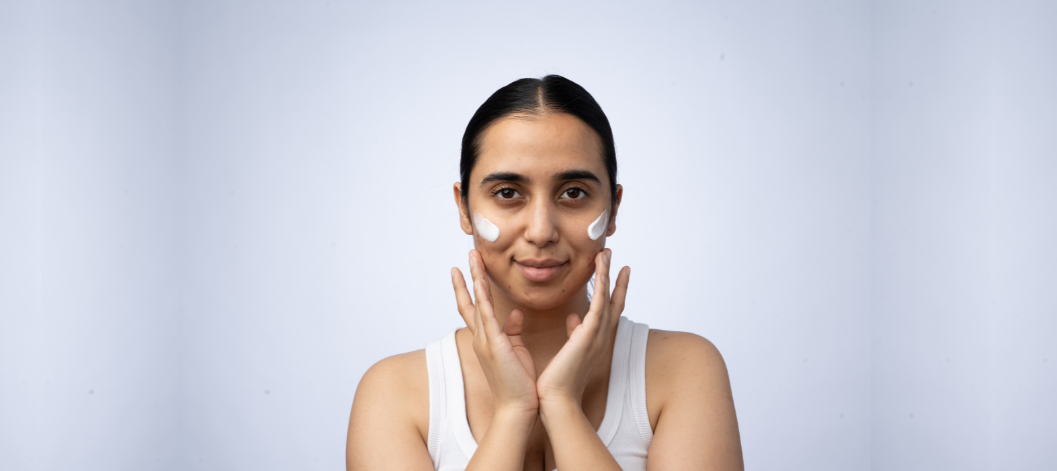
Retinol VS Hyaluronic Acid: Which one is better for treating acne, dark circles, fine lines and wrinkles
How are Retinol and Hyaluronic Acid different from each other? Retinol is widely regarded as the most effective anti-ageing topical treatment. A 2012 study highlighted Hyaluronic Acid as a key molecule in the ageing process. The study suggests that a low molecular weight variant of Hyaluronic Acid can effectively reduce the appearance of fine lines and wrinkles. Thus, both Retinol and Hyaluronic Acid can be considered effective anti-ageing treatments. But is Hyaluronic Acid as potent as Retinol? Does HA possess the ability to penetrate the deeper layers of the skin and mitigate free radicals like Retinol does? No, HA works quite differently from Retinol. Let's go over the key differences between Retinol and Hyaluronic Acid to help you determine which is better suited for your specific skin concerns. 1. Hyaluronic Acid is primarily a humectant that hydrates and retains water in the skin. Retinol, a Vitamin A derivative, promotes cell renewal and boosts collagen and elastin production. A 2021 study shows that HA can immediately boost skin hydration, making the skin smooth and plump. Whereas, Retinol stimulates collagen and elastin production in the skin, enhancing blood flow. This helps Retinol counteract skin concerns like wrinkles, fine lines, and hyperpigmentation. 2. Hyaluronic Acid mostly works on the surface of your skin, whereas Retinol penetrates deeper into the skin. Hyaluronic Acid comes in 4 variants: raw form, hydrolyzed form, alkaline form, and cross-linked form. Raw and hydrolyzed forms have high molecular weight and are unable to penetrate deeper layers of your skin. Thus, it stays on the outer layer of your skin and delivers hydration where it's required. However, alkaline (sodium hyaluronate) and cross-linked forms have low molecular weight and can penetrate the deeper layers of skin. On the other hand, over-the-counter Retinol creams are available in various concentrations, for example, 0.1% to 2%. Regardless of the concentration, Retinol has low molecules that go deep beneath the epidermis (outer layer of skin) to the dermis. 3. Hyaluronic Acid is suitable for all skin types and can be used daily, while Retinol, typically used at night, requires gradual introduction due to its potency and may initially cause irritation. Hyaluronic Acid is considered to be safe for all skin types, can be used every day, and does not cause any adverse effects. Out of all clinical trials conducted to prove the efficacy of HA—not one highlights any side effects of this ingredient. Retinol, on the flip side, requires cautious use. If you are new to Retinol, it is suggested to start with low concentration and use it once a week during your nighttime routine. Moreover, to some individuals, especially the ones with acne-prone or sensitive skin, Retinol can cause adverse reactions like purging, irritation, redness and peeling. 4. Results from Retinol can take weeks or months to show, while Hyaluronic Acid increases skin hydration immediately upon application. Retinol has numerous benefits including reducing the appearance of fine lines and wrinkles, hyperpigmentation, and acne scars. But, Retinol takes time to work. It requires consistent usage. The first few applications may even cause a few adverse effects. However, there is one short-term benefit you can expect. After a few applications, Retinol will exfoliate the dead skin cells and unclog your pores—preventing the formation of acne over time. Retinol vs Hyaluronic Acid: Which one is better for fine lines and wrinkles? If fine lines and wrinkles are among your skin concerns, look no further than Retinol. A 2006 study says that Retinoids, including Retinol, are the most promising agents available for the treatment of ageing and photoaging. Retinol increases collagen production in the skin and stimulates the production of new blood vessels—reducing the appearance of fine lines and wrinkles. Moreover, once the Retinol molecules reach the deeper layer of your skin, they reduce/balance free radicals (A 2010 study found that free radicals damage skin cells, leading to premature ageing). But, to see results, you need to be consistent with Retinol. Experts say it can take up to 6 months before the improvements in wrinkles are apparent. Retinol vs Hyaluronic Acid: Which is more suitable for treating acne? Retinol is more effective than Hyaluronic Acid when it comes to treating acne. In fact, it is approved for treating acne. A 2021 study says Retinol's anti-inflammatory properties make it highly effective in treating acne and improving hyperpigmentation. Another reason why Retinol is considered a suitable treatment for acne is its ability to unclog pores. Clogged pores, caused by a buildup of dirt, oil, or dead skin cells, are a common skin condition. They are also the most common cause of acne. On the other hand, there are not many studies that prove the effectiveness of HA for the treatment of acne. The only relevant information available is a 2017 clinical trial that says HA can regulate sebum production, helping to prevent acne over time. Excess sebum production is a major cause of acne. But HA does not target acne directly, thus Retinol is a better option. READ: How Effective is Retinol for Treating Acne? Which one is better for treating dark circles? For treating dark circles or under-eye bags, Hyaluronic Acid is a safer option. It's gentle enough to use around the eyes, unlike Retinol cream, which is quite potent and should be avoided on sensitive areas such as around the eyes, corners of the nose, and corners of the mouth. HA will hydrate and brighten the skin under the eye—reducing the appearance of dark circles. Can you use Retinol and Hyaluronic Acid together? Yes, you can use Retinol and Hyaluronic Acid together—this combination will not cause any adverse effects. In fact, these ingredients help each other work better. A clinical trial conducted to test the efficacy of a cream containing low concentration of Retinol and Hyaluronic Acid, says that the combination significantly reduces the appearance of fine lines and wrinkles. The combination can also be used to address skin concerns like pigmentary spots, uneven skin tone, and dullness. Can Hyaluronic Acid help you avoid Retinol purge? While Hyaluronic Acid may help with dryness caused by Retinol, it cannot help with skin purging. Retinol speeds up the cell renewal process—in which your skin is basically trying to get rid of all the unwanted/dead skin cells. These cells are pushed to the surface of your skin—appearing as tiny, red bumps that can be sensitive and painful when touched. But don’t worry, this is just a phase, which will last for a few days and then your skin will turn back to normal. Also keep in mind that it does not happen to everyone. During the initial phase of using Retinol—where the purging most likely occurs—you can use a hydrating moisturiser to strengthen your skin barrier. Also make sure not to use any other harsh skincare ingredient. READ: Retinol Purge? 5 Easiest Ways To Ease It References Goulden V. Guidelines for the management of acne vulgaris in adolescents. Paediatr Drugs. 2003;5(5):301-13. doi: 10.2165/00128072-200305050-00003. PMID: 12716217. Lobo, V., Patil, A., Phatak, A., & Chandra, N. (2010). Free radicals, antioxidants and functional foods: Impact on human health. Pharmacognosy Reviews, 4(8), 118-126. Mukherjee, S., Date, A., Patravale, V., Korting, H. C., Roeder, A., & Weindl, G. (2006). Retinoids in the treatment of skin aging: An overview of clinical efficacy and safety. Clinical Interventions in Aging, 1(4), 327-348. Draelos, Z. D., Diaz, I., Namkoong, J., Wu, J., & Boyd, T. (2021). Efficacy Evaluation of a Topical Hyaluronic Acid Serum in Facial Photoaging. Dermatology and Therapy, 11(4), 1385-1394. Papakonstantinou, E., Roth, M., & Karakiulakis, G. (2012). Hyaluronic acid: A key molecule in skin aging. Dermato-Endocrinology, 4(3), 253-258.
